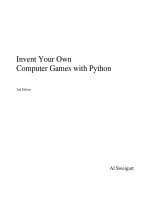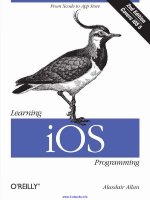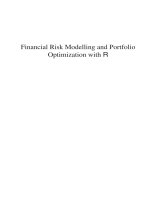Machine learning with r 2nd edition 2015 lantz
Bạn đang xem bản rút gọn của tài liệu. Xem và tải ngay bản đầy đủ của tài liệu tại đây (10.72 MB, 452 trang )
[1]
Machine Learning with R
Second Edition
Discover how to build machine learning algorithms,
prepare data, and dig deep into data prediction
techniques with R
Brett Lantz
BIRMINGHAM - MUMBAI
Machine Learning with R
Second Edition
Copyright © 2015 Packt Publishing
All rights reserved. No part of this book may be reproduced, stored in a retrieval
system, or transmitted in any form or by any means, without the prior written
permission of the publisher, except in the case of brief quotations embedded in
critical articles or reviews.
Every effort has been made in the preparation of this book to ensure the accuracy
of the information presented. However, the information contained in this book is
sold without warranty, either express or implied. Neither the author, nor Packt
Publishing, and its dealers and distributors will be held liable for any damages
caused or alleged to be caused directly or indirectly by this book.
Packt Publishing has endeavored to provide trademark information about all of the
companies and products mentioned in this book by the appropriate use of capitals.
However, Packt Publishing cannot guarantee the accuracy of this information.
First published: October 2013
Second edition: July 2015
Production reference: 1280715
Published by Packt Publishing Ltd.
Livery Place
35 Livery Street
Birmingham B3 2PB, UK.
ISBN 978-1-78439-390-8
www.packtpub.com
Credits
Author
Brett Lantz
Reviewers
Vijayakumar Nattamai Jawaharlal
Project Coordinator
Vijay Kushlani
Proofreader
Safis Editing
Kent S. Johnson
Mzabalazo Z. Ngwenya
Anuj Saxena
Commissioning Editor
Ashwin Nair
Acquisition Editor
James Jones
Content Development Editor
Natasha D'Souza
Technical Editor
Rahul C. Shah
Copy Editors
Akshata Lobo
Swati Priya
Indexer
Monica Ajmera Mehta
Production Coordinator
Arvindkumar Gupta
Cover Work
Arvindkumar Gupta
About the Author
Brett Lantz has spent more than 10 years using innovative data methods to
understand human behavior. A trained sociologist, he was first enchanted by
machine learning while studying a large database of teenagers' social networking
website profiles. Since then, Brett has worked on interdisciplinary studies of cellular
telephone calls, medical billing data, and philanthropic activity, among others. When
not spending time with family, following college sports, or being entertained by his
dachshunds, he maintains a website dedicated to
sharing knowledge about the search for insight in data.
This book could not have been written without the support of my
friends and family. In particular, my wife, Jessica, deserves many
thanks for her endless patience and encouragement. My son, Will,
who was born in the midst of the first edition and supplied
much-needed diversions while writing this edition, will be a big
brother shortly after this book is published. In spite of cautionary
tales about correlation and causation, it seems that every time I
expand my written library, my family likewise expands! I dedicate
this book to my children in the hope that one day they will be
inspired to tackle big challenges and follow their curiosity wherever
it may lead.
I am also indebted to many others who supported this book
indirectly. My interactions with educators, peers, and collaborators
at the University of Michigan, the University of Notre Dame, and the
University of Central Florida seeded many of the ideas I attempted
to express in the text; any lack of clarity in their expression is purely
mine. Additionally, without the work of the broader community
of researchers who shared their expertise in publications, lectures,
and source code, this book might not have existed at all. Finally,
I appreciate the efforts of the R team and all those who have
contributed to R packages, whose work has helped bring machine
learning to the masses. I sincerely hope that my work is likewise a
valuable piece in this mosaic.
About the Reviewers
Vijayakumar Nattamai Jawaharlal is a software engineer with an experience
of 2 decades in the IT industry. His background lies in machine learning, big data
technologies, business intelligence, and data warehouse.
He develops scalable solutions for many distributed platforms, and is very
passionate about scalable distributed machine learning.
Kent S. Johnson is a software developer who loves data analysis, statistics, and
machine learning. He currently develops software to analyze tissue samples related
to cancer research. According to him, a day spent with R and ggplot2 is a good day.
For more information about him, visit .
I'd like to thank, Gile, for always loving me.
Mzabalazo Z. Ngwenya holds a postgraduate degree in mathematical statistics
from the University of Cape Town. He has worked extensively in the field of
statistical consulting, and currently works as a biometrician at a research and
development entity in South Africa. His areas of interest are primarily centered
around statistical computing, and he has over 10 years of experience with R for data
analysis and statistical research. Previously, he was involved in reviewing Learning
RStudio for R Statistical Computing, R Statistical Application Development by Example
Beginner's Guide, R Graph Essentials, R Object-oriented Programming, Mastering Scientific
Computing with R, and Machine Learning with R, all by Packt Publishing.
Anuj Saxena is a data scientist at IGATE Corporation. He has an MS in analytics
from the University of San Francisco and an MSc in Statistics from the NMIMS
University in India. He is passionate about data science and likes using open source
languages such as R and Python as primary tools for data science projects. In his
spare time, he participates in predictive analytics competitions on kaggle.com. For
more information about him, visit .
I'd like to thank my father, Dr. Sharad Kumar, who inspired me at an
early age to learn math and statistics and my mother, Mrs. Ranjana
Saxena, who has been a backbone throughout my educational life.
I'd also like to thank my wonderful professors at the University of
San Francisco and the NMIMS University who triggered my interest
in this field and taught me the power of data and how it can be used
to tell a wonderful story.
www.PacktPub.com
Support files, eBooks, discount offers, and more
For support files and downloads related to your book, please visit www.PacktPub.com.
Did you know that Packt offers eBook versions of every book published, with PDF
and ePub files available? You can upgrade to the eBook version at www.PacktPub.com
and as a print book customer, you are entitled to a discount on the eBook copy. Get in
touch with us at for more details.
At www.PacktPub.com, you can also read a collection of free technical articles, sign
up for a range of free newsletters and receive exclusive discounts and offers on Packt
books and eBooks.
TM
/>
Do you need instant solutions to your IT questions? PacktLib is Packt's online digital
book library. Here, you can search, access, and read Packt's entire library of books.
Why subscribe?
• Fully searchable across every book published by Packt
• Copy and paste, print, and bookmark content
• On demand and accessible via a web browser
Free access for Packt account holders
If you have an account with Packt at www.PacktPub.com, you can use this to access
PacktLib today and view 9 entirely free books. Simply use your login credentials for
immediate access.
Table of Contents
Prefaceix
Chapter 1: Introducing Machine Learning
1
The origins of machine learning
2
Uses and abuses of machine learning
4
Machine learning successes
5
The limits of machine learning
5
Machine learning ethics
7
How machines learn
9
Data storage
10
Abstraction11
Generalization13
Evaluation
14
Machine learning in practice
16
Types of input data
17
Types of machine learning algorithms
19
Matching input data to algorithms
21
Machine learning with R
22
Installing R packages
23
Loading and unloading R packages
24
Summary25
Chapter 2: Managing and Understanding Data
27
R data structures
28
Vectors28
Factors30
Lists32
Data frames
35
Matrixes and arrays
37
[i]
Table of Contents
Managing data with R
Saving, loading, and removing R data structures
Importing and saving data from CSV files
Exploring and understanding data
Exploring the structure of data
Exploring numeric variables
Measuring the central tendency – mean and median
Measuring spread – quartiles and the five-number summary
Visualizing numeric variables – boxplots
Visualizing numeric variables – histograms
Understanding numeric data – uniform and normal distributions
Measuring spread – variance and standard deviation
39
39
41
42
43
44
45
47
49
51
53
54
Exploring categorical variables
56
Exploring relationships between variables
59
Measuring the central tendency – the mode
Visualizing relationships – scatterplots
Examining relationships – two-way cross-tabulations
58
59
61
Summary64
Chapter 3: Lazy Learning – Classification Using
Nearest Neighbors
Understanding nearest neighbor classification
The k-NN algorithm
Measuring similarity with distance
Choosing an appropriate k
Preparing data for use with k-NN
Why is the k-NN algorithm lazy?
Example – diagnosing breast cancer with the k-NN algorithm
Step 1 – collecting data
Step 2 – exploring and preparing the data
Transformation – normalizing numeric data
Data preparation – creating training and test datasets
Step 3 – training a model on the data
Step 4 – evaluating model performance
Step 5 – improving model performance
Transformation – z-score standardization
Testing alternative values of k
65
66
66
69
70
72
74
75
76
77
79
80
81
83
84
85
86
Summary87
Chapter 4: Probabilistic Learning – Classification
Using Naive Bayes
Understanding Naive Bayes
Basic concepts of Bayesian methods
Understanding probability
Understanding joint probability
[ ii ]
89
90
90
91
92
Table of Contents
Computing conditional probability with Bayes' theorem
The Naive Bayes algorithm
Classification with Naive Bayes
The Laplace estimator
Using numeric features with Naive Bayes
Example – filtering mobile phone spam with the
Naive Bayes algorithm
Step 1 – collecting data
Step 2 – exploring and preparing the data
Data preparation – cleaning and standardizing text data
Data preparation – splitting text documents into words
Data preparation – creating training and test datasets
Visualizing text data – word clouds
Data preparation – creating indicator features for frequent words
94
97
98
100
102
103
104
105
106
112
115
116
119
Step 3 – training a model on the data
121
Step 4 – evaluating model performance
122
Step 5 – improving model performance
123
Summary124
Chapter 5: Divide and Conquer – Classification Using
Decision Trees and Rules
Understanding decision trees
Divide and conquer
The C5.0 decision tree algorithm
Choosing the best split
Pruning the decision tree
Example – identifying risky bank loans using C5.0 decision trees
Step 1 – collecting data
Step 2 – exploring and preparing the data
Data preparation – creating random training and test datasets
Step 3 – training a model on the data
Step 4 – evaluating model performance
Step 5 – improving model performance
Boosting the accuracy of decision trees
Making mistakes more costlier than others
Understanding classification rules
Separate and conquer
The 1R algorithm
The RIPPER algorithm
Rules from decision trees
What makes trees and rules greedy?
Example – identifying poisonous mushrooms with rule learners
Step 1 – collecting data
Step 2 – exploring and preparing the data
[ iii ]
125
126
127
131
133
135
136
136
137
138
140
144
145
145
147
149
150
153
155
157
158
160
160
161
Table of Contents
Step 3 – training a model on the data
162
Step 4 – evaluating model performance
165
Step 5 – improving model performance
166
Summary169
Chapter 6: Forecasting Numeric Data – Regression Methods
171
Understanding regression
172
Simple linear regression
174
Ordinary least squares estimation
177
Correlations179
Multiple linear regression
181
Example – predicting medical expenses using linear regression
186
Step 1 – collecting data
186
Step 2 – exploring and preparing the data
187
Exploring relationships among features – the correlation matrix
Visualizing relationships among features – the scatterplot matrix
Step 3 – training a model on the data
Step 4 – evaluating model performance
Step 5 – improving model performance
Model specification – adding non-linear relationships
Transformation – converting a numeric variable to a binary indicator
Model specification – adding interaction effects
Putting it all together – an improved regression model
Understanding regression trees and model trees
Adding regression to trees
Example – estimating the quality of wines with
regression trees and model trees
Step 1 – collecting data
Step 2 – exploring and preparing the data
Step 3 – training a model on the data
Visualizing decision trees
Step 4 – evaluating model performance
Measuring performance with the mean absolute error
189
190
193
196
197
198
198
199
200
201
202
205
205
206
208
210
212
213
Step 5 – improving model performance
214
Summary218
Chapter 7: Black Box Methods – Neural Networks and
Support Vector Machines
Understanding neural networks
From biological to artificial neurons
Activation functions
[ iv ]
219
220
221
223
Table of Contents
Network topology
225
The number of layers
The direction of information travel
The number of nodes in each layer
226
227
228
Training neural networks with backpropagation
Example – Modeling the strength of concrete with ANNs
Step 1 – collecting data
Step 2 – exploring and preparing the data
Step 3 – training a model on the data
Step 4 – evaluating model performance
Step 5 – improving model performance
Understanding Support Vector Machines
Classification with hyperplanes
229
231
232
232
234
237
238
239
240
Using kernels for non-linear spaces
Example – performing OCR with SVMs
Step 1 – collecting data
Step 2 – exploring and preparing the data
Step 3 – training a model on the data
Step 4 – evaluating model performance
Step 5 – improving model performance
245
248
249
250
252
254
256
The case of linearly separable data
The case of nonlinearly separable data
Chapter 8: Finding Patterns – Market Basket Analysis Using
Association Rules
Understanding association rules
The Apriori algorithm for association rule learning
Measuring rule interest – support and confidence
Building a set of rules with the Apriori principle
Example – identifying frequently purchased groceries with
association rules
Step 1 – collecting data
Step 2 – exploring and preparing the data
Data preparation – creating a sparse matrix for transaction data
Visualizing item support – item frequency plots
Visualizing the transaction data – plotting the sparse matrix
Step 3 – training a model on the data
Step 4 – evaluating model performance
Step 5 – improving model performance
Sorting the set of association rules
Taking subsets of association rules
Saving association rules to a file or data frame
242
244
259
260
261
263
265
266
266
267
268
272
273
274
277
280
280
281
283
Summary284
[v]
Table of Contents
Chapter 9: Finding Groups of Data – Clustering with k-means
Understanding clustering
Clustering as a machine learning task
The k-means clustering algorithm
Using distance to assign and update clusters
Choosing the appropriate number of clusters
Example – finding teen market segments using k-means clustering
Step 1 – collecting data
Step 2 – exploring and preparing the data
Data preparation – dummy coding missing values
Data preparation – imputing the missing values
285
286
286
289
290
294
296
297
297
299
300
Step 3 – training a model on the data
302
Step 4 – evaluating model performance
304
Step 5 – improving model performance
308
Summary310
Chapter 10: Evaluating Model Performance
Measuring performance for classification
Working with classification prediction data in R
A closer look at confusion matrices
Using confusion matrices to measure performance
Beyond accuracy – other measures of performance
The kappa statistic
Sensitivity and specificity
Precision and recall
The F-measure
Visualizing performance trade-offs
311
312
313
317
319
321
323
326
328
330
331
ROC curves
332
Estimating future performance
The holdout method
336
336
Cross-validation
Bootstrap sampling
340
343
Summary344
Chapter 11: Improving Model Performance
Tuning stock models for better performance
Using caret for automated parameter tuning
Creating a simple tuned model
Customizing the tuning process
Improving model performance with meta-learning
Understanding ensembles
Bagging
Boosting
[ vi ]
347
348
349
352
355
359
359
362
366
Table of Contents
Random forests
369
Training random forests
Evaluating random forest performance
370
373
Summary375
Chapter 12: Specialized Machine Learning Topics
Working with proprietary files and databases
Reading from and writing to Microsoft Excel, SAS, SPSS,
and Stata files
Querying data in SQL databases
Working with online data and services
Downloading the complete text of web pages
Scraping data from web pages
Parsing XML documents
Parsing JSON from web APIs
377
378
378
379
381
382
383
387
388
Working with domain-specific data
Analyzing bioinformatics data
Analyzing and visualizing network data
Improving the performance of R
Managing very large datasets
392
393
393
398
398
Learning faster with parallel computing
404
GPU computing
Deploying optimized learning algorithms
412
413
Generalizing tabular data structures with dplyr
Making data frames faster with data.table
Creating disk-based data frames with ff
Using massive matrices with bigmemory
Measuring execution time
Working in parallel with multicore and snow
Taking advantage of parallel with foreach and doParallel
Parallel cloud computing with MapReduce and Hadoop
Building bigger regression models with biglm
Growing bigger and faster random forests with bigrf
Training and evaluating models in parallel with caret
399
401
402
404
406
406
410
411
414
414
414
Summary416
Index417
[ vii ]
Preface
Machine learning, at its core, is concerned with the algorithms that transform
information into actionable intelligence. This fact makes machine learning
well-suited to the present-day era of big data. Without machine learning,
it would be nearly impossible to keep up with the massive stream of information.
Given the growing prominence of R—a cross-platform, zero-cost statistical
programming environment—there has never been a better time to start using
machine learning. R offers a powerful but easy-to-learn set of tools that can
assist you with finding data insights.
By combining hands-on case studies with the essential theory that you need to
understand how things work under the hood, this book provides all the knowledge
that you will need to start applying machine learning to your own projects.
What this book covers
Chapter 1, Introducing Machine Learning, presents the terminology and concepts that
define and distinguish machine learners, as well as a method for matching a learning
task with the appropriate algorithm.
Chapter 2, Managing and Understanding Data, provides an opportunity to get your
hands dirty working with data in R. Essential data structures and procedures used
for loading, exploring, and understanding data are discussed.
Chapter 3, Lazy Learning – Classification Using Nearest Neighbors, teaches you how to
understand and apply a simple yet powerful machine learning algorithm to your
first real-world task—identifying malignant samples of cancer.
Chapter 4, Probabilistic Learning – Classification Using Naive Bayes, reveals the essential
concepts of probability that are used in the cutting-edge spam filtering systems.
You'll learn the basics of text mining in the process of building your own spam filter.
[ ix ]
Preface
Chapter 5, Divide and Conquer – Classification Using Decision Trees and Rules, explores a
couple of learning algorithms whose predictions are not only accurate, but also easily
explained. We'll apply these methods to tasks where transparency is important.
Chapter 6, Forecasting Numeric Data – Regression Methods, introduces machine learning
algorithms used for making numeric predictions. As these techniques are heavily
embedded in the field of statistics, you will also learn the essential metrics needed to
make sense of numeric relationships.
Chapter 7, Black Box Methods – Neural Networks and Support Vector Machines, covers
two complex but powerful machine learning algorithms. Though the math may
appear intimidating, we will work through examples that illustrate their inner
workings in simple terms.
Chapter 8, Finding Patterns – Market Basket Analysis Using Association Rules, exposes
the algorithm used in the recommendation systems employed by many retailers. If
you've ever wondered how retailers seem to know your purchasing habits better
than you know yourself, this chapter will reveal their secrets.
Chapter 9, Finding Groups of Data – Clustering with k-means, is devoted to a procedure
that locates clusters of related items. We'll utilize this algorithm to identify profiles
within an online community.
Chapter 10, Evaluating Model Performance, provides information on measuring
the success of a machine learning project and obtaining a reliable estimate of the
learner's performance on future data.
Chapter 11, Improving Model Performance, reveals the methods employed by the teams
at the top of machine learning competition leaderboards. If you have a competitive
streak, or simply want to get the most out of your data, you'll need to add these
techniques to your repertoire.
Chapter 12, Specialized Machine Learning Topics, explores the frontiers of machine
learning. From working with big data to making R work faster, the topics covered
will help you push the boundaries of what is possible with R.
What you need for this book
The examples in this book were written for and tested with R version 3.2.0 on
Microsoft Windows and Mac OS X, though they are likely to work with any
recent version of R.
[x]
Preface
Who this book is for
This book is intended for anybody hoping to use data for action. Perhaps you
already know a bit about machine learning, but have never used R; or perhaps you
know a little about R, but are new to machine learning. In any case, this book will
get you up and running quickly. It would be helpful to have a bit of familiarity with
basic math and programming concepts, but no prior experience is required. All you
need is curiosity.
Conventions
In this book, you will find a number of text styles that distinguish between different
kinds of information. Here are some examples of these styles and an explanation of
their meaning.
Code words in text, database table names, folder names, filenames, file extensions,
pathnames, dummy URLs, user input, and Twitter handles are shown as follows:
"The most direct way to install a package is via the install.packages() function."
A block of code is set as follows:
subject_name,temperature,flu_status,gender,blood_type
John Doe,
98.1,
FALSE,
MALE,
O
Jane Doe,
98.6,
FALSE,
FEMALE,
AB
Steve Graves,
101.4,
TRUE,
MALE,
A
Any command-line input or output is written as follows:
> summary(wbcd_z$area_mean)
Min. 1st Qu.
Median
-1.4530 -0.6666 -0.2949
Mean 3rd Qu.
0.0000
0.3632
Max.
5.2460
New terms and important words are shown in bold. Words that you see on the
screen, for example, in menus or dialog boxes, appear in the text like this: "The Task
Views link on the left side of the CRAN page provides a curated list of packages."
Warnings or important notes appear in a box like this.
Tips and tricks appear like this.
[ xi ]
Preface
Reader feedback
Feedback from our readers is always welcome. Let us know what you think about
this book—what you liked or disliked. Reader feedback is important for us as it
helps us develop titles that you will really get the most out of.
To send us general feedback, simply e-mail , and mention
the book's title in the subject of your message.
If there is a topic that you have expertise in and you are interested in either writing
or contributing to a book, see our author guide at www.packtpub.com/authors.
Customer support
Now that you are the proud owner of a Packt book, we have a number of things to
help you to get the most from your purchase.
Downloading the example code
You can download the example code files from your account at http://www.
packtpub.com for all the Packt Publishing books you have purchased. If you
purchased this book elsewhere, you can visit />and register to have the files e-mailed directly to you.
New to the second edition of this book, the example code is also available via
GitHub at Check here for the
most up-to-date R code, as well as issue tracking and a public wiki. Please join
the community!
Downloading the color images of this book
We also provide you with a PDF file that has color images of the screenshots/
diagrams used in this book. The color images will help you better understand the
changes in the output. You can download this file from />sites/default/files/downloads/Machine_Learning_With_R_Second_Edition_
ColoredImages.pdf.
[ xii ]
Preface
Errata
Although we have taken every care to ensure the accuracy of our content, mistakes
do happen. If you find a mistake in one of our books—maybe a mistake in the text or
the code—we would be grateful if you could report this to us. By doing so, you can
save other readers from frustration and help us improve subsequent versions of this
book. If you find any errata, please report them by visiting ktpub.
com/submit-errata, selecting your book, clicking on the Errata Submission Form
link, and entering the details of your errata. Once your errata are verified, your
submission will be accepted and the errata will be uploaded to our website or added
to any list of existing errata under the Errata section of that title.
To view the previously submitted errata, go to />content/support and enter the name of the book in the search field. The required
information will appear under the Errata section.
Piracy
Piracy of copyrighted material on the Internet is an ongoing problem across all
media. At Packt, we take the protection of our copyright and licenses very seriously.
If you come across any illegal copies of our works in any form on the Internet, please
provide us with the location address or website name immediately so that we can
pursue a remedy.
Please contact us at with a link to the suspected
pirated material.
We appreciate your help in protecting our authors and our ability to bring you
valuable content.
Questions
If you have a problem with any aspect of this book, you can contact us at
, and we will do our best to address the problem.
[ xiii ]
Introducing Machine Learning
If science fiction stories are to be believed, the invention of artificial intelligence
inevitably leads to apocalyptic wars between machines and their makers. In the
early stages, computers are taught to play simple games of tic-tac-toe and chess.
Later, machines are given control of traffic lights and communications, followed by
military drones and missiles. The machines' evolution takes an ominous turn once
the computers become sentient and learn how to teach themselves. Having no more
need for human programmers, humankind is then "deleted."
Thankfully, at the time of this writing, machines still require user input.
Though your impressions of machine learning may be colored by these mass media
depictions, today's algorithms are too application-specific to pose any danger of
becoming self-aware. The goal of today's machine learning is not to create an artificial
brain, but rather to assist us in making sense of the world's massive data stores.
Putting popular misconceptions aside, by the end of this chapter, you will gain a
more nuanced understanding of machine learning. You also will be introduced to
the fundamental concepts that define and differentiate the most commonly used
machine learning approaches.
You will learn:
• The origins and practical applications of machine learning
• How computers turn data into knowledge and action
• How to match a machine learning algorithm to your data
The field of machine learning provides a set of algorithms that transform data into
actionable knowledge. Keep reading to see how easy it is to use R to start applying
machine learning to real-world problems.
[1]
Introducing Machine Learning
The origins of machine learning
Since birth, we are inundated with data. Our body's sensors—the eyes, ears, nose,
tongue, and nerves—are continually assailed with raw data that our brain translates
into sights, sounds, smells, tastes, and textures. Using language, we are able to share
these experiences with others.
From the advent of written language, human observations have been recorded.
Hunters monitored the movement of animal herds, early astronomers recorded the
alignment of planets and stars, and cities recorded tax payments, births, and deaths.
Today, such observations, and many more, are increasingly automated and recorded
systematically in the ever-growing computerized databases.
The invention of electronic sensors has additionally contributed to an explosion in
the volume and richness of recorded data. Specialized sensors see, hear, smell, taste,
and feel. These sensors process the data far differently than a human being would.
Unlike a human's limited and subjective attention, an electronic sensor never takes a
break and never lets its judgment skew its perception.
Although sensors are not clouded by subjectivity, they do not
necessarily report a single, definitive depiction of reality. Some have
an inherent measurement error, due to hardware limitations. Others
are limited by their scope. A black and white photograph provides
a different depiction of its subject than one shot in color. Similarly, a
microscope provides a far different depiction of reality than a telescope.
Between databases and sensors, many aspects of our lives are recorded.
Governments, businesses, and individuals are recording and reporting information,
from the monumental to the mundane. Weather sensors record temperature and
pressure data, surveillance cameras watch sidewalks and subway tunnels, and
all manner of electronic behaviors are monitored: transactions, communications,
friendships, and many others.
This deluge of data has led some to state that we have entered an era of Big Data,
but this may be a bit of a misnomer. Human beings have always been surrounded
by large amounts of data. What makes the current era unique is that we have vast
amounts of recorded data, much of which can be directly accessed by computers.
Larger and more interesting data sets are increasingly accessible at the tips of our
fingers, only a web search away. This wealth of information has the potential to
inform action, given a systematic way of making sense from it all.
[2]









